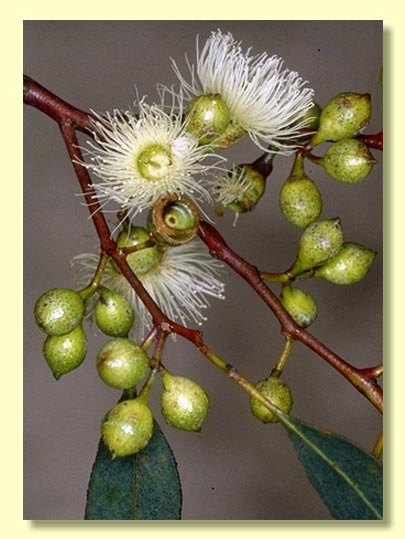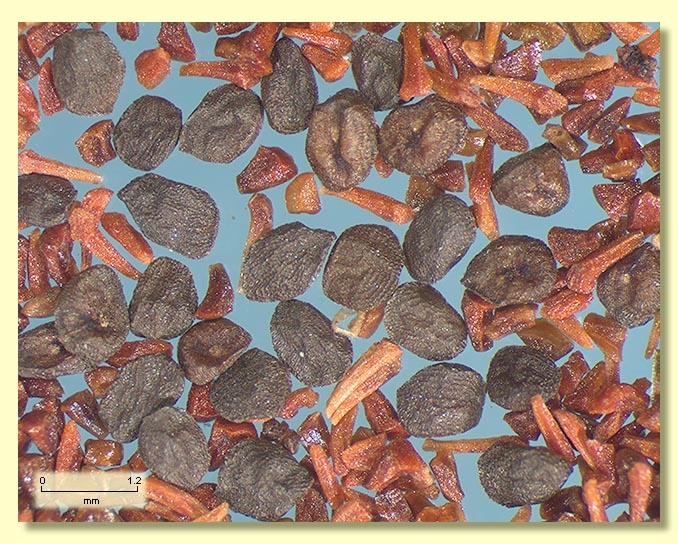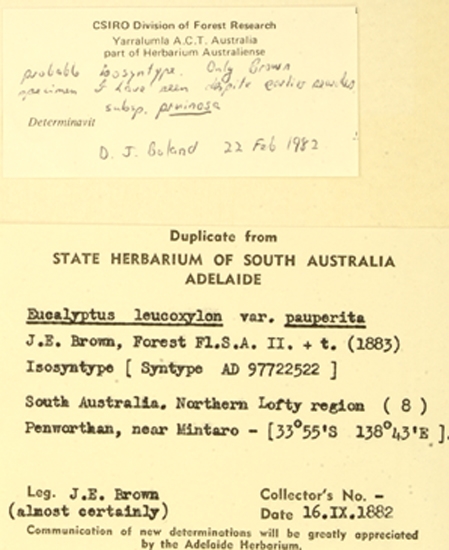Euclid - Online edition
Eucalyptus leucoxyon subsp. pruinosa
Classification
Eucalyptus | Symphyomyrtus | Adnataria | Terminales | Melliodorae | Leucoxylon
Nomenclature
Eucalyptus leucoxylon subsp. pruinosa (F.Muell. ex Miq.) Boland, Austral. Forest Res. 9: 68 (1979).
Eucalyptus leucoxylon var. pruinosa F.Muell. Ex. Miq., Ned. Kruidk. Arch. 4: 127 (1856). T: Salt Ck, S.A., Jan. 1849, F.Mueller or H.Behr; syn: Mel 1010320; Salt Ck, F.Mueller or H.Behr; syn: U 190557; fide D.J.Boland, loc. cit.
Eucalyptus leucoxylon subsp. bellarinensis K.Rule, Muelleria 11: 133 (1998). T: Grounds of Anglican Church, Ocean Grove, 4 Aug. 1996, K.Rule; holo: MEL; iso: AD, CANB, NSW. (CANB not received 29 Nov 2019)
Eucalyptus leucoxylon var. pauperita J.E.Br., Forest Fl. S. Australia 2: pl. 9 (1883). T: several syntypes; lecto: illustration accompanying original description, J.E.Brown loc. cit., fide D.J.Boland, loc. cit.
Eucalyptus leucoxylon var. pruinosa F.Muell. Ex. Miq., Ned. Kruidk. Arch. 4: 127 (1856). T: Salt Ck, S.A., Jan. 1849, F.Mueller or H.Behr; syn: Mel 1010320; Salt Ck, F.Mueller or H.Behr; syn: U 190557; fide D.J.Boland, loc. cit.
Eucalyptus leucoxylon subsp. bellarinensis K.Rule, Muelleria 11: 133 (1998). T: Grounds of Anglican Church, Ocean Grove, 4 Aug. 1996, K.Rule; holo: MEL; iso: AD, CANB, NSW. (CANB not received 29 Nov 2019)
Eucalyptus leucoxylon var. pauperita J.E.Br., Forest Fl. S. Australia 2: pl. 9 (1883). T: several syntypes; lecto: illustration accompanying original description, J.E.Brown loc. cit., fide D.J.Boland, loc. cit.
Description
Tree to 25 m tall or rarely a mallee.
Bark smooth throughout, or with some incompletely shed rough, fibrous to flaky, grey to yellowish brown bark on basal 0.5–2 m of trunk; smooth bark yellowish with blue-grey and cream patches; horizontal bark scars sometimes present; branchlets often glaucous.
Juvenile growth (coppice or wild seedling to 50 cm tall) stem rounded in cross-section, usually glaucous, smooth or warty; juvenile leaves opposite and sessile well into sapling stage, ovate to cordate, 3–9 cm long, 1.3–8 cm wide, margin entire or crenulate, base amplexicaul or rounded or pairs connate, blue-green or glaucous. Crowns sometimes with persistent juvenile and intermediate leaves.
Adult leaves alternate, petiole 0.3–2.5 cm long; blade lanceolate to falcate, 6–20 cm long, (0.8)1–3 cm wide, base tapering to petiole, concolorous, glossy or dull, green to blue-green or glaucous, side-veins at an acute or wider angle to midrib, densely to very densely reticulate, intramarginal vein parallel to and well removed from margin (sometimes doubled), oil glands island and intersectional.
Inflorescence axillary unbranched, peduncles 0.3–1(2) cm long, buds 3 per umbel, pedicels 0.2–0.9 cm long). Mature buds ovoid to globular, 0.7–1 cm long, 0.5–0.8 cm wide, green to yellow or creamy, or glaucous, scar absent, operculum conical to rounded to beaked, stamens inflexed, with outer staminodes (rarely stamens all perfect), anthers adnate, positioned obliquely at filament tip, cuboid, dehiscing by terminal pores, style long, stigma pin-head shaped, locules 4 to 6, the placentae each with 4 vertical ovule rows. Flowers white.
Fruit pedicellate (pedicels 0.1–0.9 cm long), cup-shaped to hemispherical or truncate-globose, 0.5–1.2 cm long, 0.6–1.2(1.4) cm wide, glaucous or non-glaucous, staminal ring broad, deciduous, disc descending, valves 4 to 6, near rim level or enclosed.
Seeds black, brown, or grey, 1–1.5 mm long, flattened-ovoid, dorsal surface shallowly reticulate, hilum ventral.
Cultivated seedlings (measured at ca node 10): cotyledons reniform to oblong; stems rounded in cross-section, smooth or warty, glaucous; leaves sessile, opposite for many nodes (at least 15), broadly ovate or cordate, 4–8 cm long, 2.5–6 cm wide, base amplexicaul to rounded, dull, grey-green to glaucous.
Bark smooth throughout, or with some incompletely shed rough, fibrous to flaky, grey to yellowish brown bark on basal 0.5–2 m of trunk; smooth bark yellowish with blue-grey and cream patches; horizontal bark scars sometimes present; branchlets often glaucous.
Juvenile growth (coppice or wild seedling to 50 cm tall) stem rounded in cross-section, usually glaucous, smooth or warty; juvenile leaves opposite and sessile well into sapling stage, ovate to cordate, 3–9 cm long, 1.3–8 cm wide, margin entire or crenulate, base amplexicaul or rounded or pairs connate, blue-green or glaucous. Crowns sometimes with persistent juvenile and intermediate leaves.
Adult leaves alternate, petiole 0.3–2.5 cm long; blade lanceolate to falcate, 6–20 cm long, (0.8)1–3 cm wide, base tapering to petiole, concolorous, glossy or dull, green to blue-green or glaucous, side-veins at an acute or wider angle to midrib, densely to very densely reticulate, intramarginal vein parallel to and well removed from margin (sometimes doubled), oil glands island and intersectional.
Inflorescence axillary unbranched, peduncles 0.3–1(2) cm long, buds 3 per umbel, pedicels 0.2–0.9 cm long). Mature buds ovoid to globular, 0.7–1 cm long, 0.5–0.8 cm wide, green to yellow or creamy, or glaucous, scar absent, operculum conical to rounded to beaked, stamens inflexed, with outer staminodes (rarely stamens all perfect), anthers adnate, positioned obliquely at filament tip, cuboid, dehiscing by terminal pores, style long, stigma pin-head shaped, locules 4 to 6, the placentae each with 4 vertical ovule rows. Flowers white.
Fruit pedicellate (pedicels 0.1–0.9 cm long), cup-shaped to hemispherical or truncate-globose, 0.5–1.2 cm long, 0.6–1.2(1.4) cm wide, glaucous or non-glaucous, staminal ring broad, deciduous, disc descending, valves 4 to 6, near rim level or enclosed.
Seeds black, brown, or grey, 1–1.5 mm long, flattened-ovoid, dorsal surface shallowly reticulate, hilum ventral.
Cultivated seedlings (measured at ca node 10): cotyledons reniform to oblong; stems rounded in cross-section, smooth or warty, glaucous; leaves sessile, opposite for many nodes (at least 15), broadly ovate or cordate, 4–8 cm long, 2.5–6 cm wide, base amplexicaul to rounded, dull, grey-green to glaucous.
Flowering Time
Flowering has been recorded in February, June, July, September, November and December.
Notes
Eucalyptus leucoxylon is a widespread, small to medium-sized tree species of south-eastern South Australia, west and central Victoria only extending into New South Wales just north of the River Murray in the Barham area. E. leucoxylon is a three-budded species distinguished by the many pairs of opposite, ovate juvenile leaves, smooth buds lacking an operculum scar and by the fruits which have a deciduous staminal ring. The bark may be smooth or basally fibrous somewhat like the related E. melliodora which is seven-budded. On buds and fruit alone it may be difficult to distinguish from the ironbark species E. tricarpa of south-eastern New South Wales and central and eastern Victoria.
There are four subspecies recognised in EUCLID:
E. leucoxylon subsp. leucoxylon
Occurs in well watered areas on Kangaroo Island and in the Mt Lofty Range, South Australia, and western Victoria. It is a tree to 25 m tall, non-glaucous, with ovoid buds and pedicels at least as long as the fruit. Eucalyptus leucoxylon subsp. connata from the Melbourne to Werribee and Bacchus Marsh area is included here.
E. leucoxylon subsp. pruinosa
Occurs in drier areas of south-eastern South Australia, the Wimmera and Goldfields areas of Victoria, and in New South Wales, where restricted to the Murray River floodplain near Barham. Often on deeper soils but also on stony rises. It is a tree to 25 m tall with smaller, globular, often glaucous buds and fruits. The juvenile leaves are blue-green to glaucous and sometimes connate. The mature crown may contain a proportion of bluish juvenile and intermediate leaves. This subspecies includes subsp. bellarinensis from south of Geelong. Also included is the narrow-leaved var. pauperita from the northern Mt Lofty Ranges, lower slopes of Mt Remarkable and hills south of Orroroo, Peterborough and also the foot of Mt Bryan near Burra. .
E. leucoxylon subsp. stephaniae
Occurs in the sandy areas east of Meningie and the upper south-east of South Australia and the Big Desert and Little Desert of western Victoria. It is a tree or mallee to 15 m tall, non-glaucous, with smaller juvenile leaves that are never stem-clasping or connate, shorter juvenile phase and smaller buds and fruit than the other subspecies.
E. leucoxylon subsp. megalocarpa
Strictly coastal in the far south-east of South Australia and adjacent areas of far western Victoria (e.g. the lower Glenelg River). It is a stunted tree or mallee to 15 m tall, is non-glaucous, and is distinguished by the large buds and fruit (to 1.6 cm wide) with long pedicels.
Pink or red flowers may occur in subsp. leucoxylon, subsp. megalocarpa and occasionally in subsp. stephaniae. A fifth form of E. leucoxylon is given species status, E. petiolaris (q.v.), and is endemic to Eyre Peninsula of South Australia.
Eucalyptus leucoxylon belongs in Eucalyptus subgenus Symphyomyrtus section Adnataria because the buds have two opercula, ovules are in four rows, seeds are flattened-ovoid, cotyledons are reniform, and anthers are rigid on the staminal filaments. Within section Adnataria, E. leucoxylon is part of a small subgroup series Melliodorae, further characterised by having buds in axillary clusters, the outer operculum being retained until flowering when both opercula are shed together, and the flowers having outer stamens that are sterile whilst inner stamens are fertile, and a broad staminal ring that can often be seen on the fruit but ultimately is deciduous. Other species in series Melliodorae are the box-barked E. melliodora, which is widespread from the Consuelo Tableland in central Queensland through eastern New South Wales and Victoria as far as the Grampians; the smooth-barked E. petiolaris mentioned above; and the two ironbarks, E. sideroxylon and E. tricarpa, from New South Wales and Victoria.
There are four subspecies recognised in EUCLID:
E. leucoxylon subsp. leucoxylon
Occurs in well watered areas on Kangaroo Island and in the Mt Lofty Range, South Australia, and western Victoria. It is a tree to 25 m tall, non-glaucous, with ovoid buds and pedicels at least as long as the fruit. Eucalyptus leucoxylon subsp. connata from the Melbourne to Werribee and Bacchus Marsh area is included here.
E. leucoxylon subsp. pruinosa
Occurs in drier areas of south-eastern South Australia, the Wimmera and Goldfields areas of Victoria, and in New South Wales, where restricted to the Murray River floodplain near Barham. Often on deeper soils but also on stony rises. It is a tree to 25 m tall with smaller, globular, often glaucous buds and fruits. The juvenile leaves are blue-green to glaucous and sometimes connate. The mature crown may contain a proportion of bluish juvenile and intermediate leaves. This subspecies includes subsp. bellarinensis from south of Geelong. Also included is the narrow-leaved var. pauperita from the northern Mt Lofty Ranges, lower slopes of Mt Remarkable and hills south of Orroroo, Peterborough and also the foot of Mt Bryan near Burra. .
E. leucoxylon subsp. stephaniae
Occurs in the sandy areas east of Meningie and the upper south-east of South Australia and the Big Desert and Little Desert of western Victoria. It is a tree or mallee to 15 m tall, non-glaucous, with smaller juvenile leaves that are never stem-clasping or connate, shorter juvenile phase and smaller buds and fruit than the other subspecies.
E. leucoxylon subsp. megalocarpa
Strictly coastal in the far south-east of South Australia and adjacent areas of far western Victoria (e.g. the lower Glenelg River). It is a stunted tree or mallee to 15 m tall, is non-glaucous, and is distinguished by the large buds and fruit (to 1.6 cm wide) with long pedicels.
Pink or red flowers may occur in subsp. leucoxylon, subsp. megalocarpa and occasionally in subsp. stephaniae. A fifth form of E. leucoxylon is given species status, E. petiolaris (q.v.), and is endemic to Eyre Peninsula of South Australia.
Eucalyptus leucoxylon belongs in Eucalyptus subgenus Symphyomyrtus section Adnataria because the buds have two opercula, ovules are in four rows, seeds are flattened-ovoid, cotyledons are reniform, and anthers are rigid on the staminal filaments. Within section Adnataria, E. leucoxylon is part of a small subgroup series Melliodorae, further characterised by having buds in axillary clusters, the outer operculum being retained until flowering when both opercula are shed together, and the flowers having outer stamens that are sterile whilst inner stamens are fertile, and a broad staminal ring that can often be seen on the fruit but ultimately is deciduous. Other species in series Melliodorae are the box-barked E. melliodora, which is widespread from the Consuelo Tableland in central Queensland through eastern New South Wales and Victoria as far as the Grampians; the smooth-barked E. petiolaris mentioned above; and the two ironbarks, E. sideroxylon and E. tricarpa, from New South Wales and Victoria.
Origin of Name
Copyright © CANBR 2020, all rights reserved.

Web edition hosted at https://apps.lucidcentral.org/euclid

















